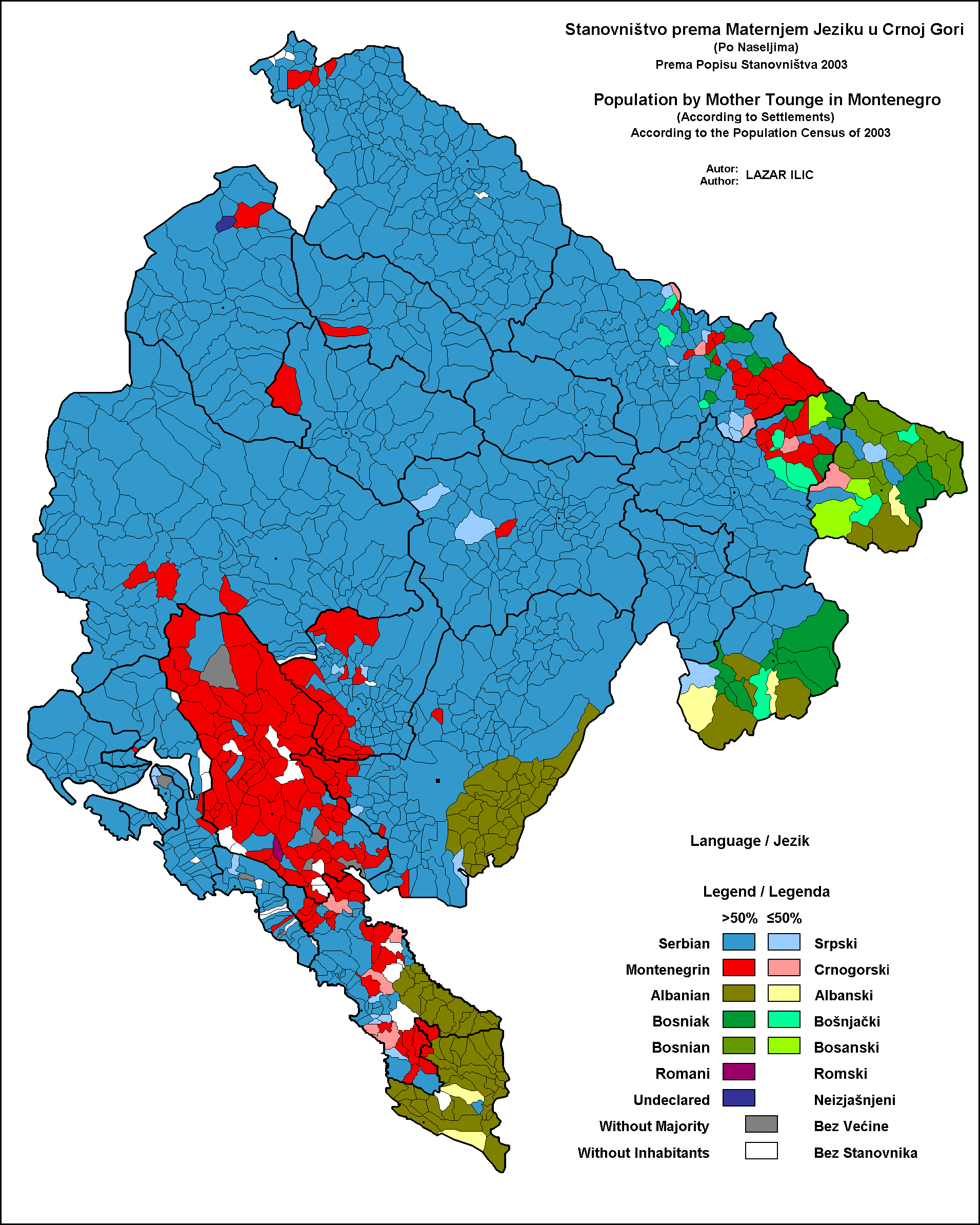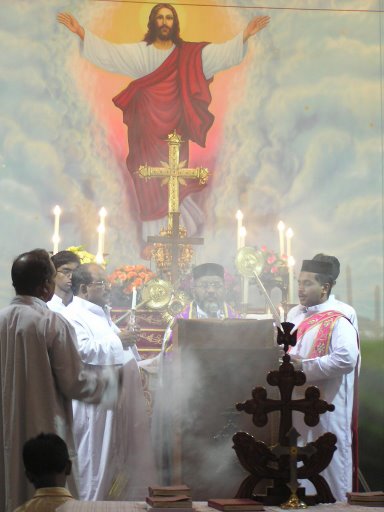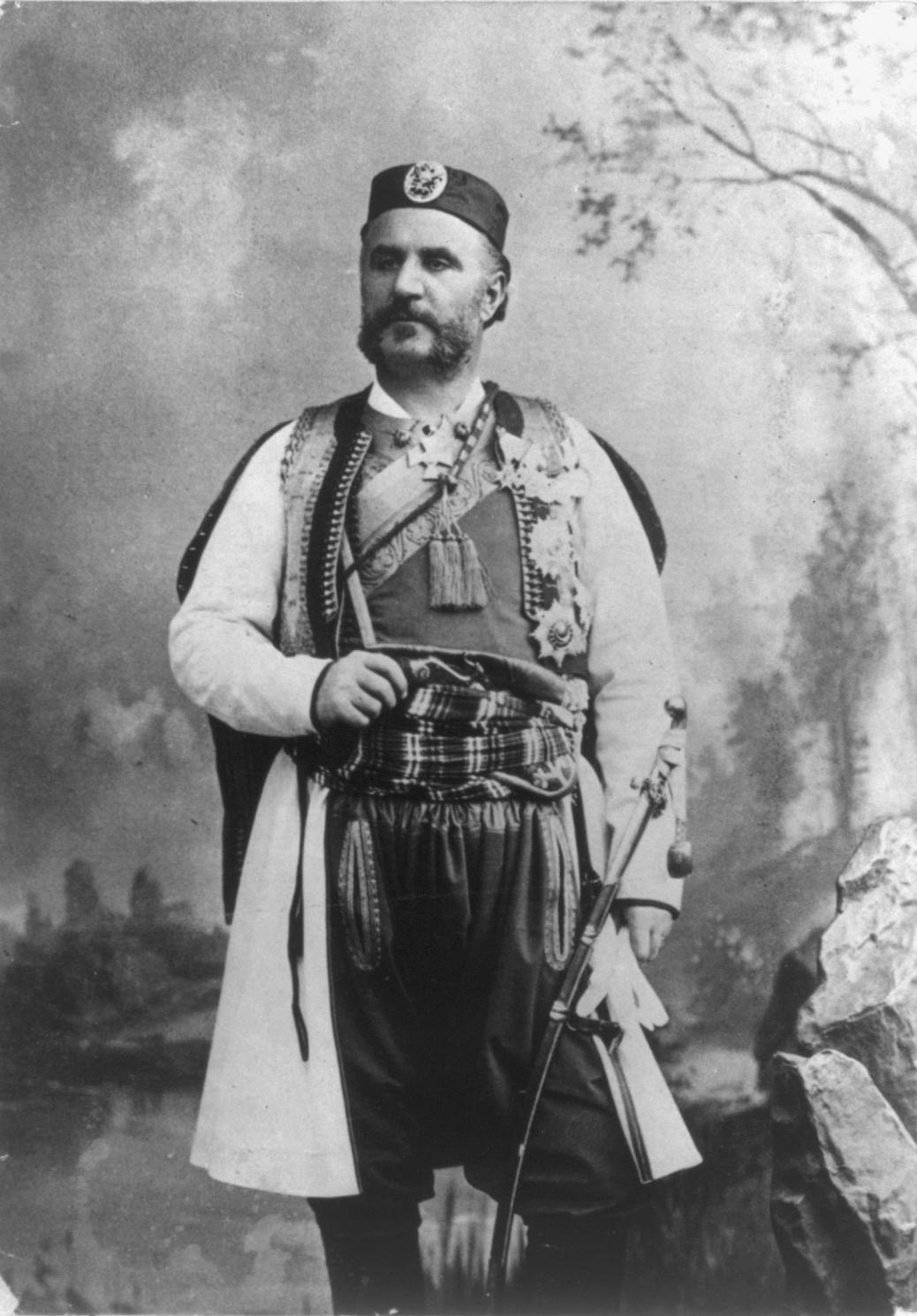|
Grahovac
Grahovac (Montenegrin Cyrillic: Граховац) is a village in western Montenegro, in the municipality of Nikšić. The village is located on a karst plateau overlooking the Grahovo field and Lake Grahovo. According to the 2011 census, it had 117 inhabitants, vast majority of which are ethnic Montenegrins. History The village is best known as the location of the Battle of Grahovac in 1858, in which Montenegro defeated the Ottoman forces, resulting in mutual redefinition and recognition of respective country borders. In order to honour the battle, prince-bishop Nikola I built the Church of the Ascension (''Crkva Svetog Spasa'') in 1864 at the exact place where Ottoman commander Hussein Pasha's tent has been set up during the battle, overlooking Lake Grahovo. In 1958, as a part of the celebration of the centenary of the battle, the church has been decorated with a memorial plaque dedicated to the fallen fighters, reading "The monument to your bravery is Montenegro and its ... [...More Info...] [...Related Items...] OR: [Wikipedia] [Google] [Baidu] |
Battle Of Grahovac
The Battle of Grahovac took place in the eponymous village of Grahovac from 11 to 13 May 1858, when the Montenegrin Grand Duke Mirko Petrović-Njegoš led the army of Principality of Montenegro against the Ottomans, ending in a decisive Montenegrin victory. After the victory, the demarcation of the border between Montenegro and the Ottoman Bosnia Eyalet was finalised. A considerable arsenal of war trophies was captured following the retreat of the Ottoman army. Background On 10 May 1858, the Ottoman commander Hussein Pasha captured the villages of Vilusi and Grahovo and continued his advance towards Grahovac, a small village located on a plateau elevated slightly above the captured area. The core of Montenegrin resistance was in Grahovac, which was the main bastion of Montenegrin defence according to military plans. Battle The fighting itself started on May 11, early in the morning. The Ottomans attacked Grahovac while Montenegrins were stubbornly defending, determ ... [...More Info...] [...Related Items...] OR: [Wikipedia] [Google] [Baidu] |
Principality Of Montenegro
The Principality of Montenegro ( sr, Књажевина Црна Горa, Knjaževina Crna Gora) was a principality in Southeastern Europe that existed from 13 March 1852 to 28 August 1910. It was then proclaimed a kingdom by Nikola I, who then became King of Montenegro. The capital was Cetinje and the Montenegrin perper was used as the state currency from 1906. The territory corresponded to the central area of modern-day Montenegro. It officially was a constitutional monarchy, but ''de facto'' was an absolute monarchy. Name In Danilo I's Code, dated to 1855, he explicitly states that he is the "''knjaz'' and ''gospodar'' of ''Crna Gora'' and '' Brda''" ( sr, / ; "prince and lord of Montenegro and Brda", "duke and lord of Montenegro and Brda"). In 1870, Nikola had the title of "''knjaz'' of ''Crna Gora'' and ''Brda''" (; "prince of Montenegro and Brda", "duke of Montenegro and Brda"), while two years later, the state was called "''Knjaževina'' of ''Crna Gora''" (; "Princi ... [...More Info...] [...Related Items...] OR: [Wikipedia] [Google] [Baidu] |
Montenegro
) , image_map = Europe-Montenegro.svg , map_caption = , image_map2 = , capital = Podgorica , coordinates = , largest_city = capital , official_languages = Montenegrin , languages2_type = Languages in official use , languages2 = , ethnic_groups = , ethnic_groups_year = 2011 , religion = , religion_year = 2011 , demonym = Montenegrin , government_type = Unitary parliamentary republic , leader_title1 = President , leader_name1 = Milo Đukanović , leader_title2 = Prime Minister , leader_name2 = Dritan Abazović (acting) , leader_title3 = Speaker , leader_name3 = Danijela Đurović , legislature = Skupština , sovereignty_type = Establishment history , established_event1 = Principality of Duklja , established_date1 ... [...More Info...] [...Related Items...] OR: [Wikipedia] [Google] [Baidu] |
Lake Grahovo
Lake Grahovo ( cg, Граховско језеро, Grahovsko јezero) is a lake in Nikšić municipality, near the town of Grahovo in southwestern Montenegro. It is an artificial lake which is an accumulation of the Grahovo River. Bottom of the lake is mostly dolomite-based. The lake itself is 700 meters long, 200 meters wide and 25 meters deep. The dam is 30 metres high, and three meters wide. The lake is a significant water reservoir used for the agricultural production of Grahovo, but is also used for sport and recreation. Construction of the dam was initiated in 1952, finished in 1962, while it has undergone a reconstruction in 1988. The source of the lake is in the area of Ševrljuga See also *Grahovo (Nikšić) *Grahovac Grahovac (Montenegrin Cyrillic: Граховац) is a village in western Montenegro, in the municipality of Nikšić. The village is located on a karst plateau overlooking the Grahovo field and Lake Grahovo. According to the 2011 census, it had ... ... [...More Info...] [...Related Items...] OR: [Wikipedia] [Google] [Baidu] |
List Of Sovereign States
The following is a list providing an overview of sovereign states around the world with information on their status and recognition of their sovereignty. The 206 listed states can be divided into three categories based on membership within the United Nations System: 193 UN member states, 2 UN General Assembly non-member observer states, and 11 other states. The ''sovereignty dispute'' column indicates states having undisputed sovereignty (188 states, of which there are 187 UN member states and 1 UN General Assembly non-member observer state), states having disputed sovereignty (16 states, of which there are 6 UN member states, 1 UN General Assembly non-member observer state, and 9 de facto states), and states having a special political status (2 states, both in free association with New Zealand). Compiling a list such as this can be a complicated and controversial process, as there is no definition that is binding on all the members of the community of nations concerni ... [...More Info...] [...Related Items...] OR: [Wikipedia] [Google] [Baidu] |
Montenegrin Language
Montenegrin ( ; cnr, label=none, / ) is a normative variety of the Serbo-Croatian language mainly used by Montenegrins and is the official language of Montenegro. Montenegrin is based on the most widespread dialect of Serbo-Croatian, Shtokavian, more specifically on Eastern Herzegovinian, which is also the basis of Standard Croatian, Serbian, and Bosnian. Montenegro's language has historically and traditionally been called either Serbian or Montenegrin. The idea of a standardized Montenegrin standard language separate from Serbian appeared in the 1990s during the breakup of Yugoslavia, through proponents of Montenegrin independence from the State Union of Serbia and Montenegro. Montenegrin became the official language of Montenegro with the ratification of a new constitution on 22 October 2007. Language standardization In January 2008, the government of Montenegro formed the Board (Council) for Standardization of the Montenegrin Language, which aims to standardize the ... [...More Info...] [...Related Items...] OR: [Wikipedia] [Google] [Baidu] |
Serbs Of Montenegro
Serbs of Montenegro ( sr, / ) or Montenegrin Serbs ( sr, / ),, meaning "Montenegrin Serbs", and meaning "Serbs Montenegrins". Specifically, Their regional autonym is simply , literal meaning "Montenegrins",Charles Seignobos, Political History of Europe, since 1814, ed. S. M. Macvane, H. Holt and Company, New York, 1900, pp. 663–664; excerpt from chapter XXI The Christian Nations of The Balkans, subchapter Servia and Montenegro, passages Montenegro the same as the ethnic group of ''Montenegrins''). In the early modern times, before the Kingdom of Montenegro, people iving within present-day borderswere divided by the identities of (; Brda), (; Old Herzegovina), (; Boka Kotorska) and (; Old Montenegro). , meaning "Serbs in Montenegro". compose native and the second largest ethnic group in Montenegro (28.7% of country's population), after the ethnic Montenegrins. Additional 0.64% of the population is made up of ''Serbs-Montenegrins'' () and ''Montenegrins-Serbs'' (). Hi ... [...More Info...] [...Related Items...] OR: [Wikipedia] [Google] [Baidu] |
Government Of Montenegro
The Government of Montenegro ( cnr, Vlada Crne Gore, Влада Црне Горе) is the executive branch of state authority in Montenegro. It is headed by the prime minister. It consists of the prime minister, the deputy prime ministers as well as the ministers. Dritan Abazović is the current Prime Minister of Montenegro and the Head of Government. The current members of the cabinet were elected on 28 April 2022, by the Parliament of Montenegro. Current ministries Each minister of each ministry reports to the Prime Minister. Ministries in the current 43nd composition of the Government of Montenegro (2022–present): * Ministry of Justice and Human and Minority Rights * Ministry of Public Administration, Digital Society and Media * Ministry of Foreign Affairs * Ministry of Interior Affairs * Ministry of Defense * Ministry of Education, Science, Culture and Sports * Ministry of Finance and Social Welfare * Ministry of Economy * Ministry of Capital Investments * Ministry ... [...More Info...] [...Related Items...] OR: [Wikipedia] [Google] [Baidu] |
Obelisk
An obelisk (; from grc, ὀβελίσκος ; diminutive of ''obelos'', " spit, nail, pointed pillar") is a tall, four-sided, narrow tapering monument which ends in a pyramid-like shape or pyramidion at the top. Originally constructed by Ancient Egyptians and called ''tekhenu'', the Greeks used the Greek term to describe them, and this word passed into Latin and ultimately English. Ancient obelisks are monolithic; they consist of a single stone. Most modern obelisks are made of several stones. Ancient obelisks Egyptian Obelisks were prominent in the architecture of the ancient Egyptians, and played a vital role in their religion placing them in pairs at the entrance of the temples. The word "obelisk" as used in English today is of Greek rather than Egyptian origin because Herodotus, the Greek traveler, was one of the first classical writers to describe the objects. A number of ancient Egyptian obelisks are known to have survived, plus the " Unfinished Obelisk" found part ... [...More Info...] [...Related Items...] OR: [Wikipedia] [Google] [Baidu] |
Feast Of The Ascension
The Solemnity of the Ascension of Jesus Christ, also called Ascension Day, Ascension Thursday, or sometimes Holy Thursday, commemorates the Christian belief of the bodily Ascension of Jesus into heaven. It is one of the ecumenical (i.e., shared by multiple denominations) feasts of Christian churches, ranking with the feasts of the Passion and Pentecost. Following the account of that the risen Jesus appeared for 40 days prior to his Ascension, Ascension Day is traditionally celebrated on a Thursday, the fortieth day of Easter; although some Christian denominations have moved the observance to the following Sunday. The day of observance varies by ecclesiastical province in many Christian denominations, as with Methodists and Catholics, for example. History The observance of this feast is of great antiquity. Eusebius seems to hint at the celebration of it in the 4th century. At the beginning of the 5th century, Augustine of Hippo says that it is of Apostolic origin, and he speaks of ... [...More Info...] [...Related Items...] OR: [Wikipedia] [Google] [Baidu] |
Nikola I Petrović-Njegoš
Nikola I Petrović-Njegoš ( sr-cyr, Никола I Петровић-Његош; – 1 March 1921) was the last monarch of Montenegro from 1860 to 1918, reigning as prince from 1860 to 1910 and as the country's first and only king from 1910 to 1918. Biography Early life Nikola was born in the village of Njeguši, the home of the reigning House of Petrović. He was the son of Mirko Petrović-Njegoš, a celebrated Montenegrin warrior (an elder brother to Danilo I of Montenegro) and his wife, Anastasija Martinovich (1824–1895). After 1696, when the dignity of vladika, or prince-bishop, became hereditary in the Petrović family, the sovereign power had descended from uncle to nephew, the vladikas belonging to the order of the black clergy (i.e., monastic clergy) who are forbidden to marry. A change was introduced by Danilo I, who declined the episcopal office, married and declared the principality hereditary in the direct male line. Mirko Petrović-Njegoš having renounced his clai ... [...More Info...] [...Related Items...] OR: [Wikipedia] [Google] [Baidu] |
Ottoman Empire
The Ottoman Empire, * ; is an archaic version. The definite article forms and were synonymous * and el, Оθωμανική Αυτοκρατορία, Othōmanikē Avtokratoria, label=none * info page on book at Martin Luther University) // CITED: p. 36 (PDF p. 38/338) also known as the Turkish Empire, was an empire that controlled much of Southeast Europe, Western Asia, and Northern Africa between the 14th and early 20th centuries. It was founded at the end of the 13th century in northwestern Anatolia in the town of Söğüt (modern-day Bilecik Province) by the Turkoman tribal leader Osman I. After 1354, the Ottomans crossed into Europe and, with the conquest of the Balkans, the Ottoman beylik was transformed into a transcontinental empire. The Ottomans ended the Byzantine Empire with the conquest of Constantinople in 1453 by Mehmed the Conqueror. Under the reign of Suleiman the Magnificent, the Ottoman Empire marked the peak of its power and prosperity, as well a ... [...More Info...] [...Related Items...] OR: [Wikipedia] [Google] [Baidu] |




.png)


